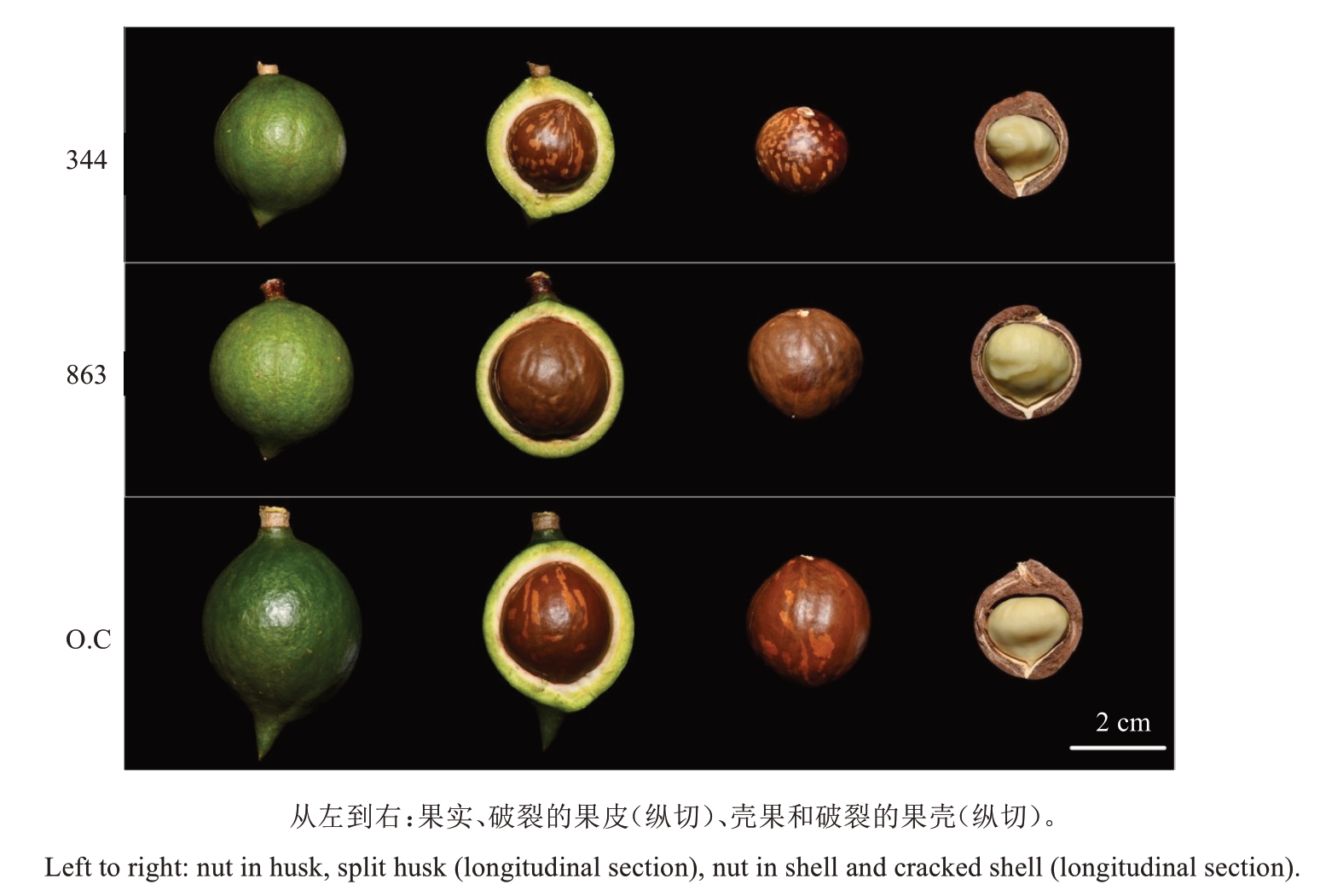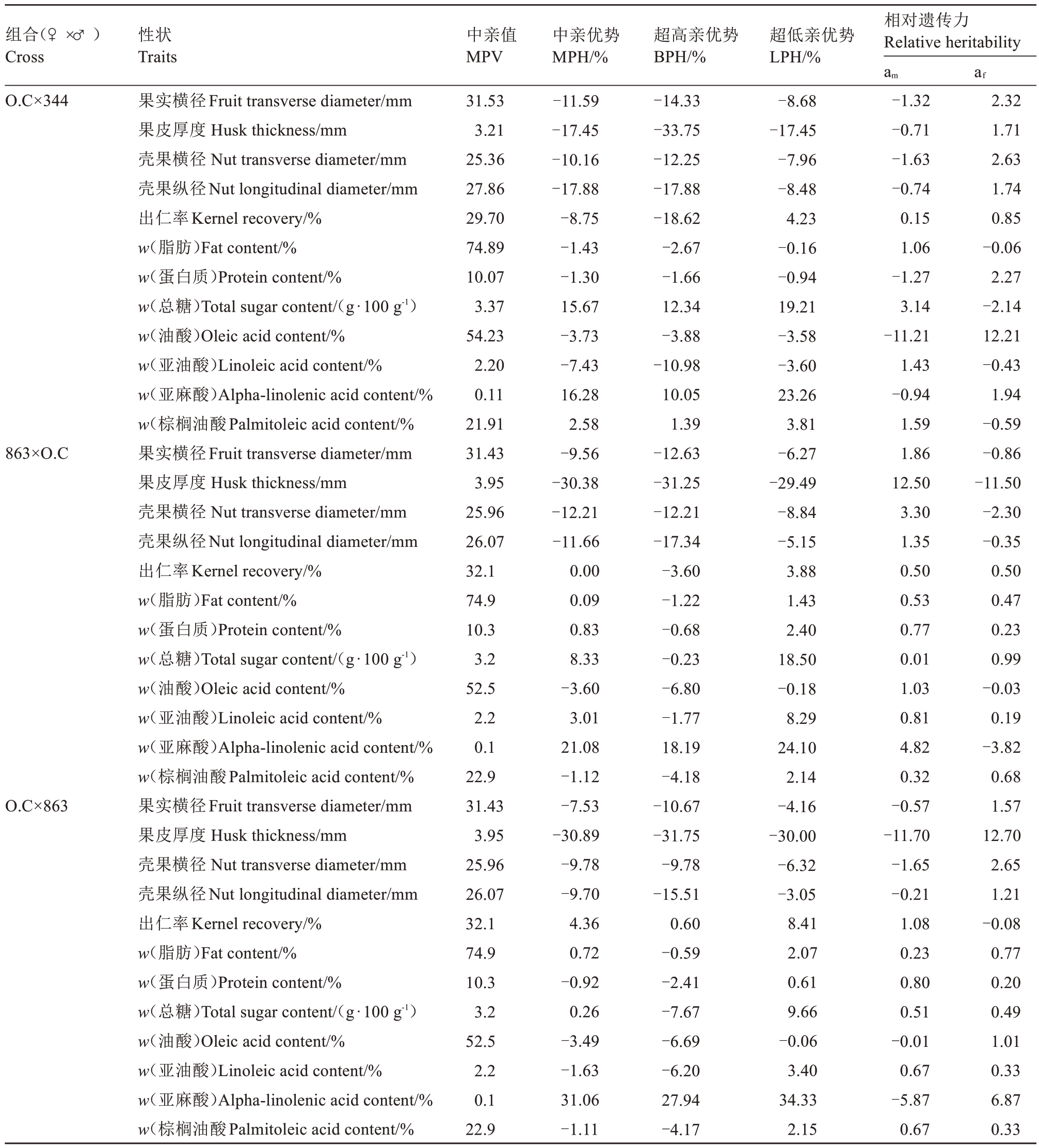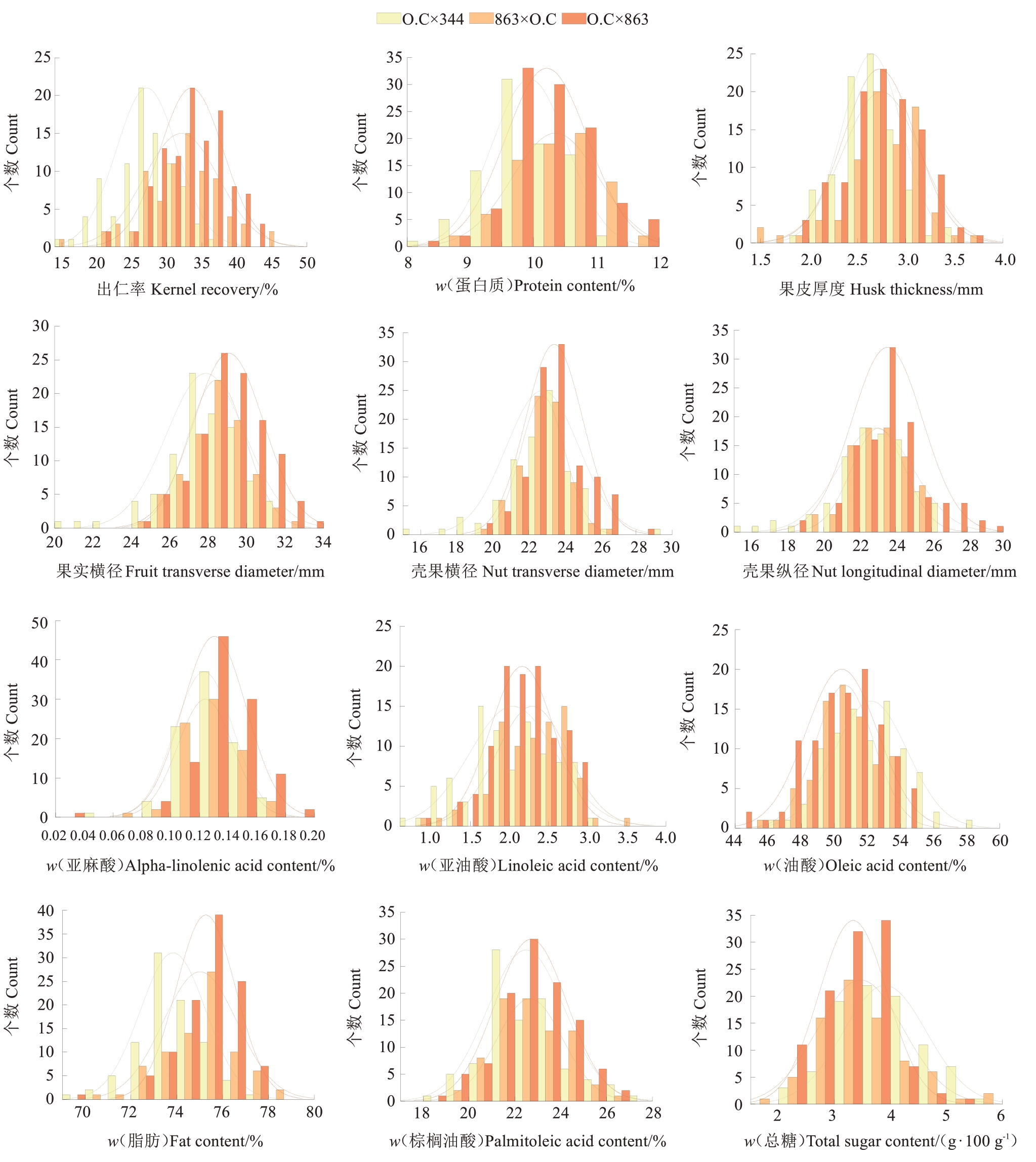澳洲坚果(Macadamia spp.)是澳大利亚本土唯一被驯化并在世界范围内广泛种植的作物[1]。澳洲坚果的驯化最早发生在美国夏威夷,距今仅有大约100 年的时间[2]。目前全球澳洲坚果的生产以夏威夷品种为主导[3]。商业栽培的品种主要源自澳洲坚果属中的两个种M. integrifolia 和M. tetraphylla,以及它们的杂交后代[4-5]。作为一种高营养价值和经济价值的坚果类作物,澳洲坚果果仁含有多种益于身体健康的不饱和脂肪酸[6],2022 年,全球澳洲坚果市场规模为15.8 亿美元,预计2023 年至2030 年将以9.3%的复合年均增长率扩大(https://www.grandviewresearch.com/)。澳洲坚果引入中国大陆的时间较短,但发展的速度极快[7]。基于引进的种质资源,国内开展了澳洲坚果选育种工作,选育出了一些高产优质新品种,如桂热1 号、南亚1 号和南亚3 号通过了全国热带作物品种审定委员会的审定。目前,国内登记及审(认)的澳洲坚果品种多以实生选种的途径获得。澳洲坚果选、育种工作促进和保障了国内澳洲坚果产业的健康持续发展。
杂交育种是果树品种选育的主要途径[8]。了解重要性状的遗传规律是杂交育种的基础[9]。卢明艳等[10]以7个梨杂交组合的196株F1为材料,分析了梨果实性状的遗传倾向,发现多个果实性状存在趋中遗传倾向。徐铭等[11]对3 个杏杂交组合共195 株F1代主要经济性状的遗传趋势进行分析,结果表明金太阳作为杂交育种亲本时,其经济性状表现出较强的遗传力。郭鑫淼等[12]调查分析了油茶杂交子代的8 个花器官性状,发现油菜杂交子代的遗传变异程度较高,具有明显的杂种优势。刘针杉等[13]探究了中国樱桃杂交F1代果实主要性状的遗传规律,认为中国樱桃果实主要性状均为多基因控制的数量性状。目前,国内外关于澳洲坚果杂交后代性状遗传分析的研究鲜见报道。笔者在本研究中以3 个澳洲坚果杂交组合的275 株杂交后代及其亲本为试验材料,通过遗传变异和杂种优势等分析,探讨其果实横径和果皮厚度等12 个果实相关性状的遗传规律,为澳洲坚果果实性状的遗传规律研究及杂交育种亲本的选配提供参考依据。
1 材料和方法
1.1 试验材料
以澳洲坚果品种O.C、344 和863 为亲本(图1),通过杂交获得的275 株杂交F1代为试验材料。其中组合O.C(♀)× 344(♂)的杂交后代89 株,组合O.C(♀)× 863(♂)的杂交后代78株,组合863(♀)× O.C(♂)的杂交后代108 株。3 个杂交组合均于2010 年杂交授粉,当年收获播种,2012 年定植于云南省热带作物科学研究所澳洲坚果选种圃(100°46′ E,22°01′ N),株距2~3 m,行距4 m,土肥水管理参照澳洲坚果栽培技术规程(NY/T 2809—2015)。目前全部株系已进入盛产期。

图1 澳洲坚果品种O.C、344 和863 的果实表型
Fig. 1 Fruit phenotypes of macadamia varieties of O.C, 344 and 863
1.2 试验方法
参考《澳洲坚果种质资源鉴定技术规范》(NY/T 1687—2009),根据果皮内部的颜色判定果实的成熟度,于2023年9月,随机选取父母本及杂交后代株系60 个生长正常的成熟果实。共测定12 个数量性状,其中5个果实表型性状分别为果实横径、果皮厚度、壳果横径、壳果纵径和出仁率,7 个果仁成分性状分别为总糖、蛋白质、脂肪、油酸、亚油酸、亚麻酸和棕榈油酸含量。
采样后,果实横径、壳果横径、壳果纵径3 个性状使用游标卡尺测量,果皮厚度使用测厚仪测量。果实去青皮后,将壳果放置于烘箱中依次在38 ℃、45 ℃和60 ℃下分别干燥48 h。壳果称质量后破壳,称取果仁质量。计算出仁率,即果仁质量与壳果质量的比值(%)。前期委托云南省分析测试中心检测50 份澳洲坚果果仁各成分含量,以建立FOSS DS2500 型近红外光谱分析仪(FOSS,USA)的澳洲坚果果仁成分测定模型。将上述破壳后的果仁经人工破碎,利用近红外光谱分析仪扫描收集光谱(波长400~2500 nm),通过已建立的模型,获得果仁中总糖、蛋白质、脂肪、油酸、亚油酸、亚麻酸和棕榈油酸成分的含量数据。
利用Office2007 进行原始数据的记录整理;采用SPSS20软件进行数据统计分析及Pearson相关性分析;采用Origin 2021 绘制果实相关性状的频率分布图,采用R(4.4.1)绘制相关性热图。研究中的各分析指标计算如下:变异系数CV/%=S/F×100;中亲优势MPV/%=(F-MP)/MP×100;超高亲优势BPH/%=(F-BP)/BP×100;超低亲优势LPH/%=(FLP)/LP×100;父本相对遗传力af=(F-Pm)/(Pf-Pm);母本相对遗传力am=(F-Pf)/(Pm-Pf)。其中,s为标准差;F 为子代平均值;MP 为亲本平均值;BP 为双亲中的高亲值;LP 为双亲中的低亲值;Pf为父本值;Pm为母本值。对12 个澳洲坚果果实数量性状参照刘孟军[14]的方法进行概率分级,按(X-1.281 8S)、(X-0.524 6S)、(X+ 0.524 6S)、(X+1.281 8S)4 个点共分为5个等级。
2 结果与分析
2.1 澳洲坚果杂交后代果实性状的变异信息
3 个澳洲坚果杂交组合后代果实性状的变异信息见表1。12个数量性状的变异系数区间为1.60%~27.10%,亚油酸含量变异系数最大,说明该性状杂交后代中出现极值的概率较大。另一个果仁成分性状脂肪含量变异系数最小,表明相较于澳洲坚果果实表型性状,果仁成分性状间的差异更为明显。在3 个杂交组合各性状变异系数的平均值中,亚油酸含量的变异系数最大(23.37%),随后是总糖含量(21.28%)、亚麻酸含量(16.35%)、出仁率(15.50%)、果皮厚度(13.32%)、壳果纵径(8.03%)、壳果横径(7.05%)、蛋白质含量(6.66%)、棕榈油酸含量(6.59%)、果实横径(6.31%)、油酸含量(4.05%)和脂肪含量(1.93%)。
表1 澳洲坚果果实性状的基本统计信息
Table 1 Basic statistical information of fruit traits of macadamia

组合(♀×♂)Cross O.C×344性状Traits母本♀父本♂863×O.C O.C×863果实横径Fruit transverse diameter/mm果皮厚度 Husk thickness/mm壳果横径 Nut transverse diameter/mm壳果纵径Nut longitudinal diameter/mm出仁率Kernel recovery/%w(脂肪)Fat content/%w(蛋白质)Protein content/%w(总糖)Total sugar content/(g·100 g-1)w(油酸)Oleic acid content/%w(亚油酸)Linoleic acid content/%w(亚麻酸)Alpha-linolenic acid content/%w(棕榈油酸Palmitoleic acid content/%果实横径Fruit transverse diameter/mm果皮厚度 Husk thickness/mm壳果横径 Nut transverse diameter/mm壳果纵径Nut longitudinal diameter/mm出仁率Kernel recovery/%w(脂肪)Fat content/%w(蛋白质)Protein content/%w(总糖)Total sugar content/(g·100 g-1)w(油酸)Oleic acid content/%w(亚油酸)Linoleic acid content/%w(亚麻酸)Alpha-linolenic acid content/%w(棕榈油酸Palmitoleic acid content/%果实横径Fruit transverse diameter/mm果皮厚度 Husk thickness/mm壳果横径 Nut transverse diameter/mm壳果纵径Nut longitudinal diameter/mm出仁率Kernel recovery/%w(脂肪)Fat content/%w(蛋白质)Protein content/%w(总糖)Total sugar content/(g·100 g-1)w(油酸)Oleic acid content/%w(亚油酸)Linoleic acid content/%w(亚麻酸)Alpha-linolenic acid content/%w(棕榈油酸Palmitoleic acid content/%32.53 4.00 25.96 27.86 33.30 73.94 10.11 3.47 54.32 2.12 0.10 22.17 30.32 3.90 25.00 24.28 30.90 75.92 10.42 2.92 50.71 2.33 0.11 23.64 32.53 4.00 25.96 27.86 33.30 73.94 10.11 3.47 54.32 2.12 0.10 22.17 30.52 3.21 24.75 25.00 26.00 75.85 10.04 3.27 54.14 2.29 0.11 21.66 32.53 4.00 25.96 27.86 33.30 73.94 10.11 3.47 54.32 2.12 0.10 22.17 30.32 3.90 25.00 24.28 30.90 75.92 10.42 2.92 50.71 2.33 0.11 23.64杂交子代 Hybrid progeny最大值Max 31.83 3.54 29.47 26.52 36.30 77.30 11.37 5.88 58.10 3.01 0.17 27.28 32.02 3.72 26.20 25.93 45.40 78.56 11.99 5.72 53.97 3.45 0.17 26.08 33.08 3.60 28.24 29.31 42.90 77.28 11.49 4.82 54.07 2.96 0.18 25.70最小值Min 20.50 1.99 15.91 15.84 15.40 68.51 8.43 2.18 46.62 0.63 0.05 18.42 24.96 1.50 19.60 19.44 15.40 69.37 8.90 1.98 45.76 0.93 0.07 19.58 25.34 1.81 19.01 18.02 20.20 72.15 8.13 2.14 44.55 0.97 0.08 20.35极差Range 11.33 1.55 13.56 10.68 20.90 8.79 2.94 3.70 11.48 2.38 0.12 8.86 7.06 2.22 6.60 6.49 30.00 9.19 3.09 3.74 8.21 2.52 0.10 6.50 7.74 1.79 9.23 11.29 22.70 5.13 3.36 2.68 9.52 1.99 0.10 5.35平均值Average 27.87 2.65 22.78 22.88 27.10 73.82 9.94 3.90 52.21 2.04 0.12 22.48 28.42 2.75 22.79 23.03 32.10 75.00 10.35 3.46 50.62 2.29 0.12 22.65 29.06 2.73 23.42 23.54 33.50 75.47 10.17 3.20 50.68 2.19 0.13 22.65标准差s 2.05 0.31 2.03 2.10 0.04 1.47 0.60 0.75 2.21 0.55 0.02 1.70 1.51 0.40 1.24 1.50 0.53 1.66 0.69 0.77 1.75 0.46 0.02 1.44 1.82 0.37 1.60 1.97 0.46 1.21 0.74 0.72 2.27 0.50 0.02 1.33变异系数CV/%7.36 11.77 8.93 9.18 16.18 1.99 6.04 19.13 4.23 27.10 16.49 7.55 5.32 14.51 5.42 6.52 16.75 2.21 6.65 22.12 3.46 20.09 15.44 6.36 6.25 13.69 6.81 8.38 13.58 1.60 7.30 22.60 4.47 22.92 17.12 5.87
2.2 澳洲坚果杂交后代果实性状的遗传分析
由表2 可知,杂交后代12 个数量性状的中亲优势在-30.89%~31.06%之间,超高亲优势在-33.75%~27.94%之间,超低亲优势在-30.00%~34.33%之间。取每个遗传参数在3 个杂交组合的平均值,其中,果实横径、果皮厚度、壳果横径、壳果纵径和油酸含量等5个性状的超亲优势为负值,说明上述5个性状在杂交后代中表现为负向超亲遗传;出仁率、脂肪、蛋白质和亚油酸含量等4 个性状的中亲优势为负值,超低亲优势为正值,表明该4 个性状在杂交后代中呈现为趋中偏低的遗传特性;棕榈油酸含量的超高亲优势为负值,而中亲优势为正值,说明该性状在杂交后代趋中偏高的遗传特性;总糖和亚麻酸含量等2 个性状的超高亲优势为正值,表明其在杂交后代的正向超亲遗传特性。
表2 澳洲坚果果实性状的杂种优势和相对遗传力
Table 2 Heterosis and the relative heritability of fruit traits of macadamia

组合(♀×♂)Cross O.C×344性状Traits中亲值MPV中亲优势MPH/%超高亲优势BPH/%超低亲优势LPH/%相对遗传力Relative heritability am af 863×O.C O.C×863果实横径Fruit transverse diameter/mm果皮厚度 Husk thickness/mm壳果横径 Nut transverse diameter/mm壳果纵径Nut longitudinal diameter/mm出仁率Kernel recovery/%w(脂肪)Fat content/%w(蛋白质)Protein content/%w(总糖)Total sugar content/(g·100 g-1)w(油酸)Oleic acid content/%w(亚油酸)Linoleic acid content/%w(亚麻酸)Alpha-linolenic acid content/%w(棕榈油酸Palmitoleic acid content/%果实横径Fruit transverse diameter/mm果皮厚度 Husk thickness/mm壳果横径 Nut transverse diameter/mm壳果纵径Nut longitudinal diameter/mm出仁率Kernel recovery/%w(脂肪)Fat content/%w(蛋白质)Protein content/%w(总糖)Total sugar content/(g·100 g-1)w(油酸)Oleic acid content/%w(亚油酸)Linoleic acid content/%w(亚麻酸)Alpha-linolenic acid content/%w(棕榈油酸Palmitoleic acid content/%果实横径Fruit transverse diameter/mm果皮厚度 Husk thickness/mm壳果横径 Nut transverse diameter/mm壳果纵径Nut longitudinal diameter/mm出仁率Kernel recovery/%w(脂肪)Fat content/%w(蛋白质)Protein content/%w(总糖)Total sugar content/(g·100 g-1)w(油酸)Oleic acid content/%w(亚油酸)Linoleic acid content/%w(亚麻酸)Alpha-linolenic acid content/%w(棕榈油酸Palmitoleic acid content/%31.53 3.21 25.36 27.86 29.70 74.89 10.07 3.37 54.23 2.20 0.11 21.91 31.43 3.95 25.96 26.07 32.1 74.9 10.3 3.2 52.5 2.2 0.1 22.9 31.43 3.95 25.96 26.07 32.1 74.9 10.3 3.2 52.5 2.2 0.1 22.9-11.59-17.45-10.16-17.88-8.75-1.43-1.30 15.67-3.73-7.43 16.28 2.58-9.56-30.38-12.21-11.66 0.00 0.09 0.83 8.33-3.60 3.01 21.08-1.12-7.53-30.89-9.78-9.70 4.36 0.72-0.92 0.26-3.49-1.63 31.06-1.11-14.33-33.75-12.25-17.88-18.62-2.67-1.66 12.34-3.88-10.98 10.05 1.39-12.63-31.25-12.21-17.34-3.60-1.22-0.68-0.23-6.80-1.77 18.19-4.18-10.67-31.75-9.78-15.51 0.60-0.59-2.41-7.67-6.69-6.20 27.94-4.17-8.68-17.45-7.96-8.48 4.23-0.16-0.94 19.21-3.58-3.60 23.26 3.81-6.27-29.49-8.84-5.15 3.88 1.43 2.40 18.50-0.18 8.29 24.10 2.14-4.16-30.00-6.32-3.05 8.41 2.07 0.61 9.66-0.06 3.40 34.33 2.15-1.32-0.71-1.63-0.74 0.15 1.06-1.27 3.14-11.21 1.43-0.94 1.59 1.86 12.50 3.30 1.35 0.50 0.53 0.77 0.01 1.03 0.81 4.82 0.32-0.57-11.70-1.65-0.21 1.08 0.23 0.80 0.51-0.01 0.67-5.87 0.67 2.32 1.71 2.63 1.74 0.85-0.06 2.27-2.14 12.21-0.43 1.94-0.59-0.86-11.50-2.30-0.35 0.50 0.47 0.23 0.99-0.03 0.19-3.82 0.68 1.57 12.70 2.65 1.21-0.08 0.77 0.20 0.49 1.01 0.33 6.87 0.33
相对遗传力可以对杂种后代的遗传动态作一定的估算和预测[15]。12 个数量性状在3 个杂交组合中的相对遗传力表明,出仁率、脂肪、蛋白质、亚油酸和棕榈油酸含量等5 个性状的相对遗传力均为正值,表明此5 个性状在杂交后代中表现为部分显性。其余7个性状亲本的相对遗传力大于1,则表明有超显性遗传。O.C 和863 正反交的杂交后代的多个性状相对遗传力表明,亲本863 分别作为母本和父本时均表现出更高的相对遗传力。
2.3 澳洲坚果杂交后代果实性状的频次分布
根据图2,果皮厚度、壳果纵径、出仁率及脂肪、蛋白质、总糖、油酸、亚油酸和棕榈油酸含量等9 个性状在3 个杂交组合中均表现正态分布(p>0.05)。果实横径和壳果横径2个性状在组合O.C× 344中存在极值,呈现为偏态分布,但在其余2 个杂交组合中均表现为正态分布。以上表明上述的11 个澳洲坚果果实性状符合多基因控制的数量性状特征。而亚麻酸含量在3 个杂交组合中,均表现为双态或偏态分布,说明其可能存在主效基因的遗传效应。

图2 3 个组合杂交后代果实相关性状的频率分布
Fig. 2 Frequency distribution of fruit traits in F1 population derived from 3 crosses
2.4 澳洲坚果杂交后代果实性状的概率分级
对12 个数量性状进行概率分级后统计各级分布频率。根据表3 所示,各性状分级频率在4.82%~46.24%之间。其中Ⅰ级频率范围为7.04%~12.17%,Ⅱ级频率范围为15.81%~26.90%,Ⅲ级频率范围为36.84%~46.24% ,Ⅳ级频率范围为15.31% ~22.53% ,Ⅴ级频率范围为4.82% ~12.22%。各等级频率的平均值中,Ⅲ级比例最大(42.14%),其次为Ⅱ级(20.12%)、Ⅳ级(19.52%)、Ⅰ级(9.48%)和Ⅴ级(8.74%)。
表3 澳洲坚果果实相关性状的概率分级和频率分布
Table 3 Probability grading and frequency distribution of macadamia fruit traits

性状Traits果实横径Fruit transverse diameter果皮厚度 Husk thickness壳果横径 Nut transverse diameter壳果纵径Nut longitudinal diameter出仁率Kernel recovery脂肪含量Fat content蛋白质含量Protein content总糖含量Total sugar content油酸含量Oleic acid content亚油酸含量Linoleic acid content亚麻酸含量Alpha-linolenic acid content棕榈油酸含量Palmitoleic acid content分级 Grade (分级频率Grade frequency/%)Ⅰ<26.15(9.86)<2.25(12.17)<20.92(9.14)<20.77(8.03)<24.7(10.88)<72.91(11.78)<9.29(8.64)<2.57(7.04)<48.51(10.37)<1.53(8.47)<0.10(7.17)<20.68(10.17)ⅡⅢⅣⅤ26.15~27.51(16.47)2.25~2.52(15.81)20.92~22.15(20.22)20.77~22.18(19.69)24.78~28.40(18.62)72.91~74.01(15.93)9.29~9.80(20.74)2.57~3.13(20.80)48.51~50.08(20.63)1.53~1.91(24.12)0.10~0.12(26.90)20.68~21.81(21.56)27.51~29.39(45.08)2.52~2.90(42.72)22.15~23.85(43.06)22.18~24.12(42.90)28.40~33.40(40.63)74.01~75.52(46.24)9.80~10.51(41.06)3.13~3.91(41.34)50.08~52.26(41.10)1.91~2.44(36.84)0.12~0.14(43.96)21.81~23.37(40.74)29.39~30.75(19.22)2.90~3.17(21.64)23.85~25.08(19.06)24.12~25.53(19.90)33.40~37.02(20.97)75.52~76.61(17.85)10.51~11.02(21.72)3.91~4.48(20.70)52.26~53.83(18.15)2.44~2.82(22.53)0.14~0.15(17.16)23.37~24.50(15.31)>30.75(9.37)>3.17(7.67)>25.08(8.51)>25.53(9.49)>37.02(8.90)>76.61(8.20)>11.02(7.84)>4.48(10.11)>53.83(9.75)>2.82(8.04)>0.15(4.82)>24.50(12.22)
2.5 澳洲坚果杂交后代果实性状的相关性分析
澳洲坚果杂交后代的12 个果实相关性状的相关性分析如图3。其中,12 个性状间呈极显著相关(p<0.01)的有26 组,显著相关(p<0.05)的有8 组。性状间表现为正相关的共31 组,表现为负相关的共35组。5个果实表型相关性状中,果实横径、果壳横径和果壳纵径等3 个性状两两之间均表现为高度正相关;果皮厚度与出仁率表现为负相关。7 个果仁成分相关性状中,脂肪含量与出仁率、亚麻酸含量表现为正相关,与油酸、蛋白质、总糖含量为负相关;蛋白质含量与亚麻酸含量为中度负相关;油酸含量与棕榈油酸含量表现为负相关;亚油酸含量与亚麻酸含量表现为正相关,与棕榈油酸含量呈负相关。各果仁成分相关性状多为中度和弱相关。

图3 澳洲坚果杂交后代果实各性状间的相关性
Fig. 3 Correlation analysis of fruit traits of macadamia hybrids
3 讨 论
出仁率是澳洲坚果育种工作中一个重要目标性状。本次研究结果显示,在3 个澳洲坚果杂交组合后代中,出仁率性状变异系数的平均值为15.50%,变异程度在5 个果实表型性状中最为丰富。此外,出仁率表现为趋中偏低的遗传特性,表明杂交后代受低出仁率亲本的影响较大。因此,在开展以出仁率为主要育种目标的杂交育种时,应选择高出仁率的双亲组合。果实横径在5 个果实表型性状中的变异系数最小,选择的潜力较小,且表现为超低亲遗传,即杂交后代趋小果型,这与前人在梨[10,16]、樱桃[13,17]、杏[11]等作物上的研究结果一致。所以,在选育大果型的澳洲坚果品种时应适当加大后代群体的数量。澳洲坚果生产实践中青睐果皮较薄,即高出果率的品种,而果皮厚度性状表现出的超低亲遗传倾向,表明实现薄果皮育种目标的难度较小。
笔者在本研究中对杂交后代的7 种果仁成分含量进行了测定。7 种果仁成分的遗传特性包含了超低遗传、趋中偏低遗传、趋中偏高遗传和超高遗传,4种不饱和脂肪酸含量的变异系数差别较大,范围为4.05%~23.37%。以上结果可为澳洲坚果品质性状的遗传改良提供参考。12 个果实性状的正态分布检验结果表明,除亚麻酸含量外,其余性状在杂交后代中均表现为正态分布。亚麻酸含量在杂交后代表现为多峰或偏态分布,表明可能存在控制亚麻酸含量的主效基因,这与王利民等[18]在胡麻中的研究结果一致。
以经验等距为基础的数量性状分级方法,不能提供客观的分级标准[19]。而利用概率分级在多种作物上都取得了理想的结果[20]。笔者在本研究中基于概率分级方法,将澳洲坚果杂交后代的12个数量性状划分为5 个等级,发现研究性状均大致符合该分级标准,研究结果可为澳洲坚果数量性状的分级标准提供依据。
目前,关于澳洲坚果果实性状间相关性的研究较多。研究对象均为澳洲坚果自然群体,研究结果之间略有差异。笔者在本研究中以遗传群体为材料,性状的相关性分析表明果实横径、壳果横径和壳果纵径等3个性状两两之间存在极显著正相关,这与以澳洲坚果自然群体为材料的研究结果相同[21-23]。研究中的出仁率分别与果实横径、壳果横径和壳果纵径等3 个性状存在正相关,与谭秋锦等[23]的研究结果相符,却与谭秋锦等[21]和万继锋等[22]的结果相反,这可能与出仁率性状受环境影响较大有关。蛋白质含量与果实横径、壳果横径和壳果纵径为负相关,这与万继锋等[22]的研究结果一致。张艳波等[24]分析了陆地棉遗传群体棉籽中的脂肪酸含量,表明油酸与亚油酸含量存在极显著负相关,然而本次研究结果中油酸与亚油酸却存在极显著正相关。
4 结 论
在澳洲坚果杂交F1代的12 个果实性状中,相对于果实表型性状,果仁品质性状的变异更为丰富,表现出更大的选择潜力。代表果型大小的果实横径和壳果横、纵径性状均表明澳洲坚果果实呈现趋于小果型的遗传倾向。12 个性状在杂交后代群体的分布检验表明,可能存在控制亚麻酸含量的主效基因,其余性状符合多基因控制的数量性状特征。
[1] ARADHYA M K,YEE L K,ZEE F T,MANSHARDT R M. Genetic variability in Macadamia[J]. Genetic Resources and Crop Evolution,1998,45(1):19-32.
[2] HARDNER C. Macadamia domestication in Hawai‘I[J]. Genetic Resources and Crop Evolution,2016,63(8):1411-1430.
[3] LIN J S,ZHANG W P,ZHANG X T,MA X K,ZHANG S C,CHEN S,WANG Y B,JIA H F,LIAO Z Y,LIN J,ZHU M T,XU X M,CAI M X,ZENG H,WAN J F,YANG W H,MATSUMOTO T,HARDNER C,NOCK C J,MING R. Signatures of selection in recently domesticated macadamia[J]. Nature Communications,2022,13(1):242.
[4] VITHANAGE V,WINKS C W. Isozymes as genetic markers for Macadamia[J]. Scientia Horticulturae,1992,49(1/2):103-115.
[5] STEIGER D L,PAUL P H,ZEE F,LIU Z Y,MING R. Genetic relationships of macadamia cultivars[J]. Euphytica,2003,132:269-277.
[6] HU W,FITZGERALD M,TOPP B,ALAM M,O’HARE T J. A review of biological functions,health benefits,and possible de novo biosynthetic pathway of palmitoleic acid in macadamia nuts[J]. Journal of Functional Foods,2019,62:103520.
[7] 李志强,吴超,贺熙勇,陶亮,耿建建,马静,宫丽丹. 基于SSR标记的澳洲坚果种质资源DNA 指纹图谱的构建[J]. 果树学报,2022,39(11):2028-2035.LI Zhiqiang,WU Chao,HE Xiyong,TAO Liang,GENG Jianjian,MA Jing,GONG Lidan. Construction of DNA fingerprint of Macadamia germplasm based on SRR markers[J]. Journal of Fruit Science,2022,39(11):2028-2035.
[8] 邓秀新,王力荣,李绍华,张绍铃,张志宏,丛佩华,易干军,陈学森,陈厚彬,钟彩虹. 果树育种40 年回顾与展望[J]. 果树学报,2019,36(4):514-520.DENG Xiuxin,WANG Lirong,LI Shaohua,ZHANG Shaoling,ZHANG Zhihong,CONG Peihua,YI Ganjun,CHEN Xuesen,CHEN Houbin,ZHONG Caihong. Retrospection and prospect of fruit breeding for last four decades in China[J]. Journal of Fruit Science,2019,36(4):514-520.
[9] 陈学森,张晶,刘大亮,冀晓昊,张宗营,张芮,毛志泉,张艳敏,王立霞,李敏. 新疆红肉苹果杂种一代的遗传变异及功能型苹果优株评价[J]. 中国农业科学,2014,47(11):2193-2204.CHEN Xuesen,ZHANG Jing,LIU Daliang,JI Xiaohao,ZHANG Zongying,ZHANG Rui,MAO Zhiquan,ZHANG Yanmin,WANG Lixia,LI Min. Genetic variation of F1 population between Malus sieversii f. neidzwetzkyana and apple varieties and evaluation on fruit characters of functional apple excellent strains[J]. Scientia Agricultura Sinica,2014,47(11):2193-2204.
[10] 卢明艳,王强,闫兴凯,武春昊,赵滢,张茂君. 梨杂交F1 果实性状遗传倾向分析[J]. 植物遗传资源学报,2024,25(2):294-302.LU Mingyan,WANG Qiang,YAN Xingkai,WU Chunhao,ZHAO Ying,ZHANG Maojun. Analysis of fruit trait genetics in F1 plants of Pyrus species[J]. Journal of Plant Genetic Resources,2024,25(2):294-302.
[11] 徐铭,刘威生,王爱德,章秋平,刘宁,张玉萍,张玉君,马小雪,刘硕. 杏主要经济性状遗传分析[J]. 果树学报,2020,37(1):1-10.XU Ming,LIU Weisheng,WANG Aide,ZHANG Qiuping,LIU Ning,ZHANG Yuping,ZHANG Yujun,MA Xiaoxue,LIU Shuo. Inheritance analysis of the main economic characters of apricot[J]. Journal of Fruit Science,2020,37(1):1-10.
[12] 郭鑫淼,袁迎春,胡观兴,姜毅,李楠昕,龚文芳. 油茶杂交子代花器官性状的遗传分析[J]. 植物遗传资源学报,2023,24(6):1649-1658.GUO Xinmiao,YUAN Yingchun,HU Guanxing,JIANG Yi,LI Nanxin,GONG Wenfang. Genetic analysis of floral organ traits in hybrid progenioes of Camellia oleifera[J]. Journal of Plant Genetic Resources,2023,24(6):1649-1658.
[13] 刘针杉,涂红霞,周荆婷,马艳,柴久凤,王旨意,杨鹏飞,杨小芹,ABBAS K,王浩,王燕,王小蓉. 中国樱桃正反交F1 代果实主要性状的遗传分析[J]. 中国农业科学,2023,56(2):345-356.LIU Zhenshan,TU Hongxia,ZHOU Jingting,MA Yan,CHAI Jiufeng,WANG Zhiyi,YANG Pengfei,YANG Xiaoqin,ABBAS K,WANG Hao,WANG Yan,WANG Xiaorong. Genetic analysis of fruits characters in reciprocal cross progenies of Chinese cherry[J]. Scientia Agricultura Sinica,2023,56(2):345-356.
[14] 刘孟军. 枣树数量性状的概率分级研究[J]. 园艺学报,1996,23(2):105-109.LIU Mengjun. Studies on the variations and probability gradings of major quantitative characters of Chinese jujube[J]. Acta Horticulturae Sinica,1996,23(2):105-109.
[15] 裴新澍. 相对遗传力理论及其在作物育种上的意义[J]. 作物学报,1964,8(2):195-216.PEI Xinshu. A preliminary account on a theory of relative heritability[J]. Acta Agronomica Sinica,1964,8(2):195-216.
[16] 崔艳波,陈慧,乐文全,张树军,伍涛,陶书田,张绍铃. ‘京白梨’与‘鸭梨’正反交后代果实性状遗传倾向研究[J]. 园艺学报,2011,38(2):215-224.CUI Yanbo,CHEN Hui,LE Wenquan,ZHANG Shujun,WU Tao,TAO Shutian,ZHANG Shaoling. Studies on genetic tendency of fruit characters in reciprocal crosses generation between ‘Jingbaili’ and ‘Yali’ pear cultivars[J]. Acta Horticulturae Sinica,2011,38(2):215-224.
[17] 王燕,刘针杉,张静,杨鹏飞,马蓝,王旨意,涂红霞,杨绍凤,王浩,陈涛,王小蓉. 中国樱桃杂交F1代花和果实若干性状遗传倾向分析[J]. 园艺学报,2022,49(9):1853-1865.WANG Yan,LIU Zhenshan,ZHANG Jing,YANG Pengfei,MA Lan,WANG Zhiyi,TU Hongxia,YANG Shaofeng,WANG Hao,CHEN Tao,WANG Xiaorong. Inheritance trend of flower and fruit traits in F1 progenies of Chinese cherry[J]. Acta Horticulturae Sinica,2022,49(9):1853-1865.
[18] 王利民,党照,赵玮,李闻娟,谢亚萍,齐燕妮,张建平. 胡麻亚麻酸含量的遗传分析[J]. 西北农业学报,2020,29(6):942-948.WANG Limin,DANG Zhao,ZHAO Wei,LI Wenjuan,XIE Yaping,QI Yanni,ZHANG Jianping. Genetic analysis of linolenic acid content by using mixed major gene plus polygene inheritance model in linseed[J]. Acta Agriculturae Boreali-occidentalis Sinica,2020,29(6):942-948.
[19] 赵海娟,刘威生,刘宁,张玉萍,章秋平,刘硕. 普通杏(Armeniaca vulgaris)种质资源果实主要数量性状变异及概率分级[J].果树学报,2013,30(1):37-42.ZHAO Haijuan,LIU Weisheng,LIU Ning,ZHANG Yuping,ZHANG Qiuping,LIU Shuo. Variation and probability grading of main quantitative traits of apricot (Armeniaca vulgaris) germplasm[J]. Journal of Fruit Science,2013,30(1):37-42.
[20] 杜庆鑫,庆军,王璐,刘攀峰,何凤,朱利利,杜红岩. 杜仲种质资源果实主要数量性状变异及概率分级[J]. 植物研究,2019,39(3):387-394.DU Qingxin,QING Jun,WANG Lu,LIU Panfeng,HE Feng,ZHU Lili,DU Hongyan. Variation and probability grading of main quantitative traits of fruits for Eucommia ulmoides germplasm[J]. Bulletin of Botanical Research,2019,39(3):387-394.
[21] 谭秋锦,王文林,韦媛荣,郑树芳,黄锡云,何铣扬,陈海生. 澳洲坚果种质果实产量相关性状的多样性分析[J]. 果树学报,2019,36(12):1630-1637.TAN Qiujin,WANG Wenlin,WEI Yuanrong,ZHENG Shufang,HUANG Xiyun,HE Xianyang,CHEN Haisheng. Diversity analysis of fruit traits related to yield in Macadamia germplasms[J].Journal of Fruit Science,2019,36(12):1630-1637.
[22] 万继锋,邹明宏,陈菁,宋喜梅,杨倩,罗炼芳,曾辉. 澳洲坚果种质资源数量分类研究[J]. 果树学报,2022,39(10):1798-1812.WAN Jifeng,ZOU Minghong,CHEN Jing,SONG Ximei,YANG Qian,LUO Lianfang,ZENG Hui. Study on numerical taxonomy of Macadamia spp. germplasm resources[J]. Journal of Fruit Science,2022,39(10):1798-1812.
[23] 谭秋锦,韦媛荣,潘贞珍,环秀菊,潘浩男,许鹏,韦哲君,郑树芳,王文林. 澳洲坚果种质果实数量性状分析与综合评价[J].植物遗传资源学报,2023,24(6):1615-1625.TAN Qiujin,WEI Yuanrong,PAN Zhenzhen,HUAN Xiuju,PAN Haonan,XU Peng,WEI Zhejun,ZHENG Shufang,WANG Wenlin. Analysis and comprehensive evaluation of the fruit quantitative traits for Macadamia germplasms[J]. Journal of Plant Genetic Resources,2023,24(6):1615-1625.
[24] 张艳波,王袁,冯甘雨,段慧蓉,刘海英. 棉籽油分和3 种主要脂肪酸含量QTL 分析[J]. 作物学报,2022,48(2):380-395.ZHANG Yanbo,WANG Yuan,FENG Ganyu,DUAN Huirong,LIU Haiying. QTLs analysis of oil and three main fatty acid contents in cottonseeds[J]. Acta Agronomica Sinica,2022,48(2):380-395.